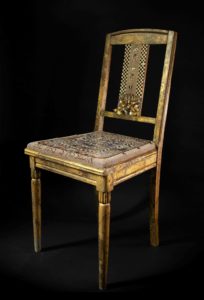 Sauve qui peut (la vie) (Save who can (the life))
Sauve qui peut (la vie) (Save who can (the life))
Séverine Gambier
2016
Ancient porcelain and faience plates, Italian glass paste, pearls, beans, glass flowers, resin and patina on a wooden chair
93 cm x 40 cm x 40 cm
The sculpture “Sauve qui peut (la vie)” (Save who can (the life)) by Séverine Gambier, is an ancient wooden chair, decorated by fragments of porcelain and faience plates as mosaic. Around the main image on the seat surface, there are pearls and beans arranged. These materials are also applied on the middle piece of the back of the chair. Here they surround two smaller mosaics. Laterally are rectangle porcelain pieces in chequered pattern. Additionally, there is a relief of figures and golden leaves at the bottom of the backs middle piece.
Notably the mosaic on the seat surface recall other oeuvres of the artist. The motive of broken and recomposed human depictions is recurring. In our case, there is a black and white image of a woman, probably a dancer from around 1900 with her public. The picture is embedded in fragments of flowers and ornaments. A frame of black and white rectangles underlines the setting of a stage. Below the scenery is a banner with the words “plus lourdement tombé” (~most heavily fallen) It is not clear, whether this comment pertains to the dancer or to the four soldiers beneath, a picture which is turned upside down outside of the frame.
 Laterally outside of this frame are two half portraits of uniformed men. These portraits are coming from series of plates from the French faience manufactory Sarreguemines, representing politicians from the end of the 19th century. Accompanied by the four soldiers and a scene of two children playing with a washtub, they are also embedded in fragments of flowers and ornaments and framed. A third level with smaller portraits and pastoral illustrations surrounds the former two.
Laterally outside of this frame are two half portraits of uniformed men. These portraits are coming from series of plates from the French faience manufactory Sarreguemines, representing politicians from the end of the 19th century. Accompanied by the four soldiers and a scene of two children playing with a washtub, they are also embedded in fragments of flowers and ornaments and framed. A third level with smaller portraits and pastoral illustrations surrounds the former two.
Even though, the arrangement seems to be in an orderly manner, a certain disorder arises from the fragmentation of the pieces and the apparently disjoint composition of the single elements. Deliberately, Séverine destroys the representations, before recomposing them in a new chaotic context, to ensure an absence of a nostalgic glorification. The randomly interspersed red flowers symbolise for the artist punches of protest against an established order. At the same time, there are the decorative elements, which correspond to her desire of harmony.
Herewith, this and other mosaics by Séverine are an expression of her personal feelings, her injuries, her resurgences and the inner chaos caused by the experience of life. Beyond that, there are references to life in general. Explicitly the inscription at the outer pearl decorated edge is an allusion to attentiveness. The appeal “Ne pas s’asseoir” (Do not sit down) is not meant as interdiction, but as request for regardfulness. On one hand, it is related to the fragility of the chair and its precious decoration. On the other hand, it refers to the movement “Nuit debout” (Up All Night), arisen in 2016, the same year as the creation of the chair. Provoked by a modification of the labour law, people in Paris and throughout France, united as a kind of assembly to discuss social challenges and propose solutions. It was an alternative form of protest, where every participant was entitled to speak and to vote. It is a kind of invitation to join in and not to give up, to remain standing upright, thus, not to sit down.
Moreover, the inscription might recall René Magritte’s “The Treachery of Images” with its caption “This is not a Pipe”. Even though the painting depicts a pipe in a realistic manner, it is only the representation of a pipe. In this direction, Séverine’s chair, which was originally a chair to use as seat, would have been transformed into an artwork and lost its initial function. Now it’s more a representation of a chair. The inscription could point to this. Additionally, provided with the sentence “Do not sit down” it also reminds the signs “Please do not touch” in museums. Does the chair become a museums object in the sense of Marcel Duchamp? If so, this could increase the quality of the chair as artwork. However, the artist’s motivation was another.
Besides, the title refers to the film of the same name by Jean-Luc Godard from 1980. The movie recounts the story of three persons at a turning point of their lives. Even though, there are no direct links in Séverine’s artwork itself, both oeuvres are reflecting on the incidents, which make an impact on the life of individuals.
Séverine Gambier
Born in 1956 in Paris, Séverine Gambier grew up in an artistic environment. Despite, or because of that, she never had a classical artistic education. After her high school graduation, she frequented the cinema world and dreamt of making films of her own. During practicing different kind of jobs, she pursued writing, painting, drawing and made collages. Confirming her predilection to outsider art, she visited exhibitions of “art brut” including the historic show “Les Singuliers de l’art” at the Musée d’Art moderne de la Ville de Paris in 1978. At the same time, she discovered the works of Adolf Wölfli and Aloïse Corbaz.
A painful cut in Séverine’s life was the premature death of her husband. Revealed originally during hiding a hole in a bathroom wall, the mosaic became essential to her work at the end of the 1990s. For the artist, it is a medium of fragmentation, fracture and splinter, but at the same time an expression of reconstitution and reconstruction. Herewith she could express her emotional chaos. It was an artistic translation of her confused feelings, her wounds and scars. By the time being, the feelings got more universal: How can one connect the chaos of the world with the need to create harmony in one’s internal disorder? How to weaken the symbols of power? How to point to the absentees, the forgotten, the unheard?
As answer to these and other questions, Séverine developed her own language. For example, she shatters ancient plates with portraits of past politicians and assemble them in a new context, like in our artwork of the month March 2022. She embeds the fragments of porcelain in splinters of flowers and ornaments to introduce beauty. Here, red flowers are a symbol for rebellion. Besides the destruction of the ancient powers, she refers to the people who created these and other ceramics long ago and today unknown, bygone for our awareness. Herewith, she returns grace to these people to calm down the anger.
Séverine had her first exhibition in 1988 at the Galerie Caroline Corre, Paris. Since 2006, she is represented by the Galerie Béatrice Soulié, Paris then Marseille. The gallery regularly participates with Séverine’s works at the Outsider Art Fair, Paris. In 2019, her oeuvres were part of the HEY! 4, a recurring show of outsider art, in the Halle Saint-Pierre, which is a centre of art brut in Paris. In 2021, Séverine worked with the French drawer Mad Meg for the exhibition “Dell’ Ornamento” (From Ornament) in the Galerie Gasparelli Arte Contemporanea in Fano, Italy. This was the departing point for further shows in Italy. For a cooperation between the Galerie Gasparelli and the Gallerie D406, the original exhibition was enlarged. The result was displayed at the Art Verona in October and The Others Art Fair in Turin one month later. From November 2021 to March 2022, works of both artists were on view at the “Marginalia” in Pavia and will be shown in May 2022 at the BOOMing Contemporary Art Show in Bologna by the Galleria D406. A newly created tryptic will be presented in June 2022 in France. It will be exposed in the Fondation Bernardaud in Limoges, city of porcelain.
Séverine lives and works in Paris.
